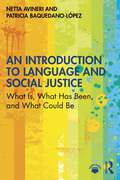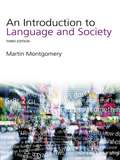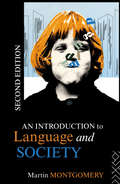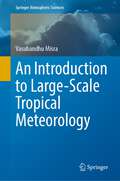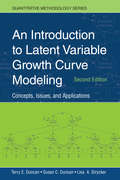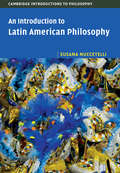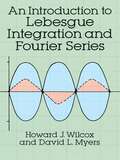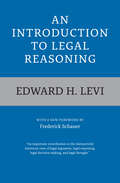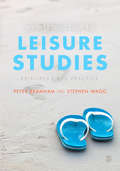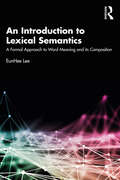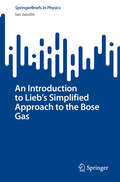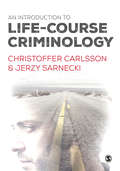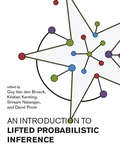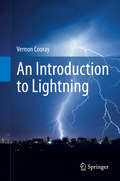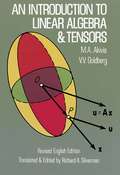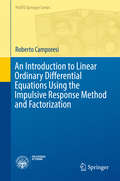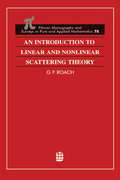- Table View
- List View
An Introduction to Language and Linguistics
by Ralph Fasold Jeff Connor-LintonThis accessible textbook is the only introduction to linguistics in which each chapter is written by an expert who teaches courses on that topic, ensuring balanced and uniformly excellent coverage of the full range of modern linguistics. Assuming no prior knowledge the text offers a clear introduction to the traditional topics of structural linguistics (theories of sound, form, meaning, and language change), and in addition provides full coverage of contextual linguistics, including separate chapters on discourse, dialect variation, language and culture, and the politics of language. There are also up-to-date separate chapters on language and the brain, computational linguistics, writing, child language acquisition, and second-language learning. The breadth of the textbook makes it ideal for introductory courses on language and linguistics offered by departments of English, sociology, anthropology, and communications, as well as by linguistics departments.
An Introduction to Language and Social Justice: What Is, What Has Been, and What Could Be
by Netta Avineri Patricia Baquedano-LópezThis innovative, interdisciplinary course textbook is designed to provide the who, what, where, when, why, and how of the intersections of language, inequality, and social justice in North America, using the applied linguistic anthropology (ALA) framework. Written in accessible language and at a level equally legible for advanced undergraduate and graduate students, this text connects theory and practice by sketching out relevant historical background, introducing theoretical and conceptual underpinnings, illustrating with case studies, discussing a wide range of key issues, and explaining research methodologies. Using a general-to-specialized content structure, the expert authors then show readers how to apply these principles and lessons in communities in the real world, to become advocates and change agents in the realm of language and social justice. With an array of useful pedagogical resources and practical tools including discussion questions and activities, reflections and vignettes, further reading and a glossary, along with additional online resources for instructors, this is the essential text for students from multiple perspectives across linguistics, applied linguistics, linguistic anthropology, and beyond.
An Introduction to Language and Society (Studies In Culture And Communication Ser.)
by Martin MontgomeryIn this third edition of the bestselling classic textbook, Martin Montgomery explores the key connections between language and social life. Guiding the student through discussions on child language, accent and dialect, social class and gender, as well as a number of other topics, Montgomery provides a comprehensive and accessible introduction to the function of language in modern society. This third edition includes: new sections on dialect levelling and estuary English; hip-hop and rapping as anti-language and ‘crossing’ between Creole, Panjabi and South Asian English new material on the Gulf War and the 'War on Terror' discussions on language in internet usage and new technologies updated examples and references. With detailed suggestions for further reading and practical work for each chapter, An Introduction to Language and Society is the ideal resource for students and teachers of Communication Studies and Language Studies.
An Introduction to Language and Society (Studies in Culture and Communication)
by Martin MontgomeryAn Introduction to Language and Society explores how our ways of seeing and engaging with the world may be shaped by the categories, systems and patterns of language. This second edition includes new material on gender, register, the speech community, language and subcultures, and language and representation.
An Introduction to Laplace Transforms and Fourier Series (Springer Undergraduate Mathematics Series)
by Phil DykeLaplace transforms continue to be a very important tool for the engineer, physicist and applied mathematician. They are also now useful to financial, economic and biological modellers as these disciplines become more quantitative. Any problem that has underlying linearity and with solution based on initial values can be expressed as an appropriate differential equation and hence be solved using Laplace transforms. In this book, there is a strong emphasis on application with the necessary mathematical grounding. There are plenty of worked examples with all solutions provided. This enlarged new edition includes generalised Fourier series and a completely new chapter on wavelets. Only knowledge of elementary trigonometry and calculus are required as prerequisites. An Introduction to Laplace Transforms and Fourier Series will be useful for second and third year undergraduate students in engineering, physics or mathematics, as well as for graduates in any discipline such as financial mathematics, econometrics and biological modelling requiring techniques for solving initial value problems.
An Introduction to Large-Scale Tropical Meteorology (Springer Atmospheric Sciences)
by Vasubandhu MisraThis upper-undergraduate/graduate-level textbook introduces students to large-scale tropical climate circulation and its variations, covering their fundamental aspects and our current understanding of how they are impacted in a warming world. From this volume, readers will gain an understanding of tropical climate variability from the meso- to planetary scale. Uniquely, equal emphasis is placed on atmospheric and oceanic processes of tropical phenomena. The book will appeal to senior undergraduate and graduate students across geoscience disciplines, including in meteorology, oceanography, geography, hydrology, and environmental science.
An Introduction to Latent Variable Growth Curve Modeling: Concepts, Issues, and Application, Second Edition (Quantitative Methodology Series)
by Terry E. Duncan Susan C. Duncan Lisa A. StryckerThis book provides a comprehensive introduction to latent variable growth curve modeling (LGM) for analyzing repeated measures. It presents the statistical basis for LGM and its various methodological extensions, including a number of practical examples of its use. It is designed to take advantage of the reader’s familiarity with analysis of variance and structural equation modeling (SEM) in introducing LGM techniques. Sample data, syntax, input and output, are provided for EQS, Amos, LISREL, and Mplus on the book’s CD. Throughout the book, the authors present a variety of LGM techniques that are useful for many different research designs, and numerous figures provide helpful diagrams of the examples. Updated throughout, the second edition features three new chapters—growth modeling with ordered categorical variables, growth mixture modeling, and pooled interrupted time series LGM approaches. Following a new organization, the book now covers the development of the LGM, followed by chapters on multiple-group issues (analyzing growth in multiple populations, accelerated designs, and multi-level longitudinal approaches), and then special topics such as missing data models, LGM power and Monte Carlo estimation, and latent growth interaction models. The model specifications previously included in the appendices are now available on the CD so the reader can more easily adapt the models to their own research. This practical guide is ideal for a wide range of social and behavioral researchers interested in the measurement of change over time, including social, developmental, organizational, educational, consumer, personality and clinical psychologists, sociologists, and quantitative methodologists, as well as for a text on latent variable growth curve modeling or as a supplement for a course on multivariate statistics. A prerequisite of graduate level statistics is recommended.
An Introduction to Latin American Economics: Understanding Theory Through History
by Scott McKinneyThis textbook serves as an introduction to the major economic topics and events in Latin America’s history, from the settling of the region by indigenous Americans and then Europeans, Africans and Asians, to the economic consequences of COVID-19. Each chapter concentrates on a particular period—for example, pre-Columbian America, the 1980s debt crisis, the 21st Century decline in income inequality—and introduces the concepts needed to understand the events of that period. These concepts include theories such as Dutch Disease and Dependency Theory, policies such as import-substituting industrialization and neoliberalism, and analytical tools such as the circular flow of income and the foreign exchange market. Descriptive data are used to illustrate these concepts: for example, Latin America’s current account balance during the 1970s and 1980s shows the impact of the debt crisis, while the relationship between money supply growth and inflation in Argentina during the 1980s and 1990s shows the impact of expansionary monetary policy and convertibility.With its focus on Latin American economic history and on the key concepts for understanding that history, this book can serve as the core textbook for an introductory course on Latin American Economics, or as a complementary text for an introductory course in Latin American Studies or a social science course on Latin America.
An Introduction to Latin American Philosophy (Cambridge Introductions to Philosophy)
by Susana NuccetelliLatin American philosophy is best understood as a type of applied philosophy devoted to issues related to the culture and politics of Latin America. This introduction provides a comprehensive overview of its central topics. It explores not only the unique insights offered by Latin American thinkers into the traditional pre-established fields of Western philosophy, but also the many 'isms' developed as a direct result of Latin American thought. Many concern matters of practical ethics and social and political philosophy, such as Lascasianism, Arielism, Bolívarism, modest and immodest feminisms, republicanism, positivism, Marxism, and liberationism. But there are also meta-philosophical 'isms' such as originalism and perspectivism. Together with clear and accessible discussions of the major issues and arguments, the book offers helpful summaries, suggestions for further reading, and a glossary of terms. It will be valuable for all readers wanting to explore the richness and diversity of Latin American philosophy.
An Introduction to Law
by Phil HarrisNesta's life is thrown into upheaval when she gets involved in charity work thinking that it might be a cool way to meet people (mainly boys). But as her eyes are opened to the plight of the world, she begins to genuinely want to get involved and help others. On top of this, Nesta meets William, a boy who questions her motives. At times, she's convinced he hates her and the feeling is mutual. But Izzie, Lucy and T. J. think it is something more like love.
An Introduction to Law and Regulation: Text and Materials (Law in Context)
by Karen Yeung Sofia RanchordásContemporary life relies on regulation. The quality and safety of the water we drink, the food we eat, and the social media applications we use are all governed by multiple regulatory regimes. Although rooted in law, regulation is a multidisciplinary endeavour. Debates about regulation, particularly in the face of rapid change and the emergence of new 'risks', are now commonplace. Despite extensive scholarship, regulation is often poorly understood, even by policy-makers, with unintended and even disastrous consequences. This book offers a critical introduction to core theories, concepts, methods, tools, and techniques of regulation, including regulatory policy, instruments, enforcement, compliance, accountability and legitimacy. Weaving extracts from texts drawn from many disciplines with accessible commentary, it introduces this important field to students, scholars, and practitioners in a scholarly yet accessible and engaging manner with discussion questions and additional readings for those seeking to deepen their knowledge.
An Introduction to Lebesgue Integration and Fourier Series (Dover Books on Mathematics)
by David L. Myers Howard J. WilcoxThis book arose out of the authors' desire to present Lebesgue integration and Fourier series on an undergraduate level, since most undergraduate texts do not cover this material or do so in a cursory way. The result is a clear, concise, well-organized introduction to such topics as the Riemann integral, measurable sets, properties of measurable sets, measurable functions, the Lebesgue integral, convergence and the Lebesgue integral, pointwise convergence of Fourier series and other subjects.The authors not only cover these topics in a useful and thorough way, they have taken pains to motivate the student by keeping the goals of the theory always in sight, justifying each step of the development in terms of those goals. In addition, whenever possible, new concepts are related to concepts already in the student's repertoire.Finally, to enable readers to test their grasp of the material, the text is supplemented by numerous examples and exercises. Mathematics students as well as students of engineering and science will find here a superb treatment, carefully thought out and well presented , that is ideal for a one semester course. The only prerequisite is a basic knowledge of advanced calculus, including the notions of compactness, continuity, uniform convergence and Riemann integration.
An Introduction to Legal Reasoning
by Edward H. LeviThis volume will be of interest and value to students of logic, ethics, and political philosophy, as well as to members of the legal profession and to everyone concerned with problems of government and jurisprudence. By citing a large number of cases, the author makes his presentation of the processes of judicial interpretation particularly lucid.
An Introduction to Leisure Studies: Principles and Practice
by Stephen Wagg Dr Peter Bramham"There are textbooks galore, but there aren't many crafted as intelligently as this one. This book will change the way that students understand leisure. It will give them an easier entry to that place where difficult ideas fuse into something intelligible, where real understanding sits and the educated imagination is stirred." - Tony Blackshaw, Sheffield Hallam University Peter Bramham and Stephen Wagg provide a foundation for those studying within the broad field of leisure studies. The book gives students an accessible and engaging introduction to leisure studies and leisure research, encouraging students to engage in reflexive analysis of their common sense understandings of everyday life and enabling them to develop an understanding of contemporary leisure studies and changing leisure practices.
An Introduction to Lexical Semantics: A Formal Approach to Word Meaning and its Composition
by EunHee LeeAn Introduction to Lexical Semantics provides a comprehensive theoretical overview of lexical semantics, analysing the major lexical categories in English: verbs, nouns, adjectives, adverbs and prepositions. The book illustrates step-by-step how to use formal semantic tools. Divided into four parts, covering the key aspects of lexical semantics, this book: introduces readers to the major influential theories including the syntax-lexical semantics interface theory by Levin and Rappaport and Pinker, the generative lexicon theory by Pustejovsky and formal semantic analyses discusses key topics in formal semantics including metonymy, metaphor and polysemy illustrates how to study word meaning scientifically by discussing mathematical notions applied to compositional semantics. Including reflection questions, summaries, further reading and practice exercises for each chapter, this accessible guide to lexical semantics is essential reading for advanced students and teachers of formal semantics.
An Introduction to Lieb's Simplified Approach to the Bose Gas (SpringerBriefs in Physics)
by Ian JauslinThis book explores Lieb's Simplified approach to the ground state of systems of interacting bosons. While extensive research has delved into the behavior of interacting bosons, persistent challenges, such as proving Bose-Einstein condensation, remain. Introduced by Lieb in 1963, the Simplified approach has been the object of renewed attention in recent years, revealing surprising and promising results. Notably, this approach provides ground state energy predictions that agree with many-body systems asymptotically at both low and high densities. It further predicts a condensate fraction and correlation function that agree with Bogolyubov theory at low densities, and numerical predictions match quantum Monte Carlo simulations across all densities. This suggests that Lieb's Simplified approach could serve as a potent tool for reimagining the study of interacting bosons. The book defines Lieb's Simplified approach, discusses its predictions, and presents known analytical and numerical results. It is designed for advanced students and young researchers working in the fields of mathematical physics, quantum many-body physics and Bose-Einstein condensates.
An Introduction to Life-Course Criminology
by Jerzy Sarnecki Christoffer CarlssonMost people engage in crime at some point in their lives, but why does almost everybody stop soon after? And, why do a small number of offenders persist in crime? These two questions constitute the core of the field often known as life-course criminology. This book provides a comprehensive introduction to life-course criminology. It covers the dominant theories and methodologies in the field and equips you with all you need to succeed in your studies on the subject. The book: Discusses the methodologies of life-course and longitudinal research Explains and critiques the major theories of life-course criminology Considers the issues of risk, prediction, onset, persistence and desistance of criminal activity Draws on research from studies in Europe, the UK, US and Australia, including the Stockholm Life-Course Project Written by two leading figures in the field, this is an authoritative text that will guide you through your studies in life-course criminology, criminal career research, and developmental criminology.
An Introduction to Life-Course Criminology
by Jerzy Sarnecki Christoffer CarlssonMost people engage in crime at some point in their lives, but why does almost everybody stop soon after? And, why do a small number of offenders persist in crime? These two questions constitute the core of the field often known as life-course criminology. This book provides a comprehensive introduction to life-course criminology. It covers the dominant theories and methodologies in the field and equips you with all you need to succeed in your studies on the subject. The book: Discusses the methodologies of life-course and longitudinal research Explains and critiques the major theories of life-course criminology Considers the issues of risk, prediction, onset, persistence and desistance of criminal activity Draws on research from studies in Europe, the UK, US and Australia, including the Stockholm Life-Course Project Written by two leading figures in the field, this is an authoritative text that will guide you through your studies in life-course criminology, criminal career research, and developmental criminology.
An Introduction to Lifted Probabilistic Inference (Neural Information Processing series)
by David PooleRecent advances in the area of lifted inference, which exploits the structure inherent in relational probabilistic models.Statistical relational AI (StaRAI) studies the integration of reasoning under uncertainty with reasoning about individuals and relations. The representations used are often called relational probabilistic models. Lifted inference is about how to exploit the structure inherent in relational probabilistic models, either in the way they are expressed or by extracting structure from observations. This book covers recent significant advances in the area of lifted inference, providing a unifying introduction to this very active field. After providing necessary background on probabilistic graphical models, relational probabilistic models, and learning inside these models, the book turns to lifted inference, first covering exact inference and then approximate inference. In addition, the book considers the theory of liftability and acting in relational domains, which allows the connection of learning and reasoning in relational domains.
An Introduction to Lightning
by Vernon CoorayThis book about lightning summarizes the essence of physics and effects of lightning in a non-technical manner and provides an up-to-date description of the phenomenon of lightning in simple language. Starting with the myths related to lightning, the reader is introduced to the mechanism of lightning flashes and their interactions with humans, human-made systems and Earth's environment. Most of the available books on lightning are written for the experts in the field and there is a need for a book that introduces the undergraduate and beginning post graduate students to the subject of lightning and prepares them for more advanced books meant for the experts. This introductory book, which is based on a series of lectures given to undergraduate and postgraduate students in electrical engineering, is intended to fill this need. Tailored to the needs of university students who plan to study electrical engineering, meteorology, environmental or basic physics, it is also a valuable reference resource for laymen who are interested in knowing more on this phenomenon.
An Introduction to Linear Algebra
by Ravi P. Agarwal Elena Cristina FlautThe techniques of linear algebra are used extensively across the applied sciences, and in many different areas of algebra such as group theory, module theory, representation theory, ring theory, and Galois theory. Written by experienced researchers with a decades of teaching experience, Introduction to Linear Algebra is a clear and rigorous introductory text on this key topic for students of both applied sciences and pure mathematics.
An Introduction to Linear Algebra (Dover Books on Mathematics)
by L. MirskyThis work provides an elementary and easily readable account of linear algebra, in which the exposition is sufficiently simple to make it equally useful to readers whose principal interests lie in the fields of physics or technology. The account is self-contained, and the reader is not assumed to have any previous knowledge of linear algebra. Although its accessibility makes it suitable for non-mathematicians, Professor Mirsky's book is nevertheless a systematic and rigorous development of the subject. Part I deals with determinants, vector spaces, matrices, linear equations, and the representation of linear operators by matrices. Part II begins with the introduction of the characteristic equation and goes on to discuss unitary matrices, linear groups, functions of matrices, and diagonal and triangular canonical forms. Part II is concerned with quadratic forms and related concepts. Applications to geometry are stressed throughout; and such topics as rotation, reduction of quadrics to principal axes, and classification of quadrics are treated in some detail. An account of most of the elementary inequalities arising in the theory of matrices is also included. Among the most valuable features of the book are the numerous examples and problems at the end of each chapter, carefully selected to clarify points made in the text.
An Introduction to Linear Algebra and Tensors (Dover Books on Mathematics)
by Richard A. Silverman M. A. Akivis V. V. GoldbergThe present book, a valuable addition to the English-language literature on linear algebra and tensors, constitutes a lucid, eminently readable and completely elementary introduction to this field of mathematics. A special merit of the book is its free use of tensor notation, in particular the Einstein summation convention. The treatment is virtually self-contained. In fact, the mathematical background assumed on the part of the reader hardly exceeds a smattering of calculus and a casual acquaintance with determinants.The authors begin with linear spaces, starting with basic concepts and ending with topics in analytic geometry. They then treat multilinear forms and tensors (linear and bilinear forms, general definition of a tensor, algebraic operations on tensors, symmetric and antisymmetric tensors, etc.), and linear transformation (again basic concepts, the matrix and multiplication of linear transformations, inverse transformations and matrices, groups and subgroups, etc.). The last chapter deals with further topics in the field: eigenvectors and eigenvalues, matrix ploynomials and the Hamilton-Cayley theorem, reduction of a quadratic form to canonical form, representation of a nonsingular transformation, and more. Each individual section -- there are 25 in all -- contains a problem set, making a total of over 250 problems, all carefully selected and matched. Hints and answers to most of the problems can be found at the end of the book.Dr. Silverman has revised the text and numerous pedagogical and mathematical improvements, and restyled the language so that it is even more readable. With its clear exposition, many relevant and interesting problems, ample illustrations, index and bibliography, this book will be useful in the classroom or for self-study as an excellent introduction to the important subjects of linear algebra and tensors.
An Introduction to Linear Ordinary Differential Equations Using the Impulsive Response Method and Factorization (PoliTO Springer Series)
by Roberto CamporesiThis book presents a method for solving linear ordinary differential equations based on the factorization of the differential operator. The approach for the case of constant coefficients is elementary, and only requires a basic knowledge of calculus and linear algebra. In particular, the book avoids the use of distribution theory, as well as the other more advanced approaches: Laplace transform, linear systems, the general theory of linear equations with variable coefficients and variation of parameters. The case of variable coefficients is addressed using Mammana's result for the factorization of a real linear ordinary differential operator into a product of first-order (complex) factors, as well as a recent generalization of this result to the case of complex-valued coefficients.
An Introduction to Linear and Nonlinear Scattering Theory (Monographs And Surveys In Pure And Applied Math #78)
by G F RoachThis monograph has two main purposes, first to act as a companion volume to more advanced texts by gathering together the principal mathematical topics commonly used in developing scattering theories and, in so doing, provide a reasonable, self-contained introduction to linear and nonlinear scattering theory for those who might wish to begin working in the area. Secondly, to indicate how these various aspects might be applied to problems in mathematical physics and the applied sciences. Of particular interest will be the influence of boundary conditions.

